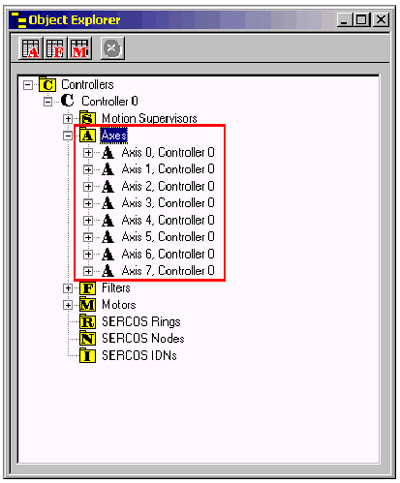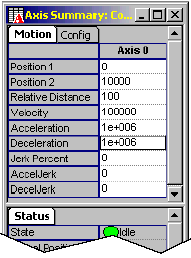 Axis Objects
Axis Objects
Axis
objects are classically associated with a single vector of motion,
particularly as it relates to a specific motor. In Motion Console,
Axis objects bridge the control link between Filters and Motion
Supervisors.
Configuration
Attributes: "Motion" Tab Page
The
following attributes appear on the Motion configuration tab
page:
- Position
1-- Target position when user clicks on

- Position
2-- Target position when user clicks on

|
Note
|
Either Position
1 or 2 can be the target position at the end of the move.
Position 1 is where the axis will be commanded to move when
the user clicks on  .
. |
- Velocity--
Command velocity during move (in encoder counts / second).
- Acceleration--
Command acceleration during move (in encoder counts / sec2).
- Deceleration--
Command deceleration during move (in encoder counts / sec2).
- Jerk
Percent-- Percentage of acceleration / deceleration curve
utilized for transitioning between Acceleration, Velocity,
and Deceleration components. In the figure below, the effects
of various Jerk Percent values are illustrated for a simple
triangular profile move.
Configuration
Attributes: "Config" Tab Page
The
following attributes appear on the General Config tab page:
- Save
to Flash-- Pre-selects current Axis settings
for saving to flash memory. For more information on using
Save to Flash, see the description
in the first part of this chapter.
- View
Sub-objects-- Shows all sub-objects for Axis object.
For more information, see Object Summary
Windows.
- Filter
Map-- Displays the Axis Filter Map Configuration window.
For more information, see Object List
Configuration Dialog Boxes.
- Pos.
Tol., Fine-- Fine Positional Tolerance. Maximum allowable
positional deviation (error) from target position to be
considered done.
- Pos.
Tol., Coarse-- Coarse Positional Tolerance. Arbitrarily
set deviation (error) from target position.
|
Note
|
The Pos.
Tol., Coarse parameter is useful for triggering auxillary
events just prior to attaining target position. (E.g.,
on an automated milling machine, Pos. Tol., Coarse
can be used to trigger the flow of cutting fluid when
the tool is close to the object being milled.) |
- Velocity
Tol.-- Velocity Tolerance. Maximum allowable velocity
deviation (error) from target velocity to be considered
"at velocity."
- Settling
Time-- Minimum time interval for both the Fine Pos[itional]
Tol[erance] and Velocity Tol[erance] attributes
to qualify as "done."
|
Note
|
As they approach
their target positions / velocities, all axes will spend
some interval of time settling. Only when an axis attains
both its Fine Positional Tolerance and Velocity
Tolerance within the Settling Time is that
axis regarded as truly "done"; this triggers
a Motion Done event (See Motion
Supervisor objects). |
- Settle
on Stop -- When checked, the settling criteria is applied
to moves halted by a stop.
- Settle
on E-Stop -- When checked, the settling criteria is
applied to moves halted by an E-Stop.
Status
Parameters
- Actual
Position -- Real, current position of axis. Where the
axis actually is.
- Command
Position -- Commanded axis position. Where the axis should
be.
- Position
Error -- Difference between Command and Actual
positions.
- Velocity
-- Command velocity.
- Acceleration
-- Command acceleration.
- State
-- Current state of the axis.
Motion States
and Descriptions
|
Motion
State
|
Description
|
|

|
Moving
toward target position 1.
|
|

|
Moving
toward target position 2.
|
|

|
Moving
when not commanded to move. NOTE: this occurs when
another application commands a move while Motion Console
is displaying the MS.
|
|

|
Error
state
|
|

|
Idle
|

  |
 .
.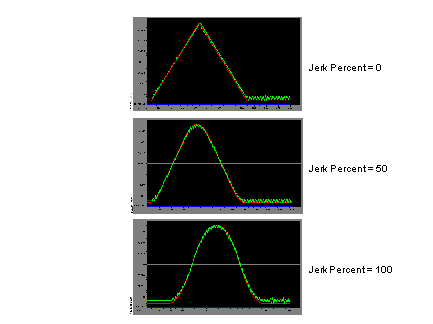
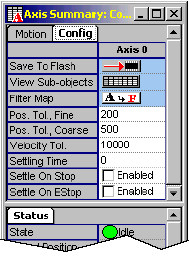
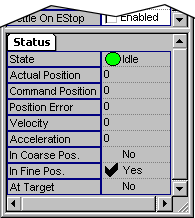
 Axis Objects
Axis Objects